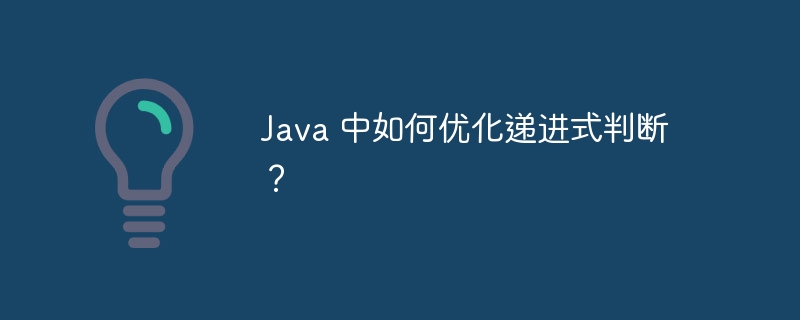Java 中如何优化递进式判断?

java中递进式判断如何优化?
在代码中,使用了嵌套的 if-else 语句来判断四个字符串变量是否为空。当变量数量较多时,这种递进式判断方式会变得冗长且难以维护。
优化方案
方案一:使用 switch-case 语句
这种方法将不同的判别条件映射到特定的整型值,然后使用 switch-case 语句进行判断。
public class judgeoptimize {
private static final int code_condition_one = 0000;
private static final int code_condition_two = 0001;
private static final int code_condition_three = 0011;
private static final int code_condition_four = 0111;
private static final int code_condition_five = 1111;
private static void test(string a, string b, string c, string d) {
switch (init(a, b, c, d)) {
case code_condition_one:
// do something ...
break;
case code_condition_two:
// do something ...
break;
case code_condition_three:
// do something ...
break;
case code_condition_four:
// do something ...
break;
case code_condition_five:
// do something ...
break;
}
}
private static int init(string... allparam) {
if (allparam == null) {
return 1;
}
string resultnumberstr = "";
for (string s : allparam) {
resultnumberstr += stringutils.isnotempty(s) ? 0 : 1;
}
return integer.valueof(resultnumberstr);
}
}方案二:使用自动化的反射
这种方法通过反射来动态调用预定义的处理方法。当判别条件数量较多时,这种方法更灵活和可维护。
import java.lang.reflect.InvocationTargetException; import java.lang.reflect.Method; import java.util.HashMap; import java.util.List; import java.util.Arrays; public class SolutionTwo { private static Object result; private static class Action { private Class<?> targetInvokeClass; private String targetMethodName; private Class<?>[] parameterTypes; private Object[] params; private boolean isCurrentClass; private boolean isNoParams; public Action() { } public Action(Class<?> targetInvokeClass, String targetMethodName, Class<?>[] parameterTypes, Object[] params, boolean isCurrentClass, boolean isNoParams) { this.targetInvokeClass = targetInvokeClass; this.targetMethodName = targetMethodName; this.parameterTypes = parameterTypes; this.params = params; this.isCurrentClass = isCurrentClass; this.isNoParams = isNoParams; } } private static final HashMap<Object, Action> ACTION_MAP = new HashMap<>(); static class ResultAction { public void helloWorld(String name) { System.out.println(name + ",你好世界"); } } static { // 都不为空 ACTION_MAP.put(0, new Action(ResultAction.class, "helloWorld", new Class[]{String.class}, new String[]{"我是张三"}, false, false)); // abc不为空,d为空 ACTION_MAP.put(1, new Action(ResultAction.class, "helloWorld", new Class[]{String.class}, new String[]{"我是李四"}, false, false)); // ab不为空,cd为空 ACTION_MAP.put(11, new Action(ResultAction.class, "helloWorld", new Class[]{String.class}, new String[]{"我是王五"}, false, false)); // a不为空,bcd为空 ACTION_MAP.put(111, new Action(ResultAction.class, "helloWorld", new Class[]{String.class}, new String[]{"我是赵六"}, false, false)); // abcd都为空 ACTION_MAP.put(1111, new Action(ResultAction.class, "helloWorld", new Class[]{String.class}, new String[]{"我是张三他爹"}, false, false)); } private static void test(String a, String b, String c, String d) { int result = init(a, b, c, d); Action action = ACTION_MAP.get(result); if (action != null) { handler(action); } else { System.out.println("未找到对应映射键"); } } private static void handler(Action action) { try { Method method = null; Class<?> cls = null; if (action.isCurrentClass()) { method = getMethod(SolutionTwo.class, action.getTargetMethodName(), action.getParameterTypes()); cls = SolutionTwo.class; } else { Class<?> targetClass = action.getTargetInvokeClass(); method = getMethod(targetClass, action.getTargetMethodName(), action.getParameterTypes()); cls = action.getTargetInvokeClass(); } result = method.invoke(cls.newInstance(), action.getParams()); } catch (NoSuchMethodException | IllegalAccessException | InvocationTargetException | InstantiationException e) { e.printStackTrace(); } } private static Method getMethod(Class<?> cls, String methodName, Class<?>[] parameterTypes) throws NoSuchMethodException { return cls.getMethod(methodName, parameterTypes); } private static int init(String... allParam) { if (allParam == null) { return 1; } String resultNumberStr = ""; for (String s : allParam) { resultNumberStr += StringUtils.isNotEmpty(s) ? 0 : 1; } return Integer.valueOf(resultNumberStr); } }
以上就是Java 中如何优化递进式判断?的详细内容,更多请关注其它相关文章!
